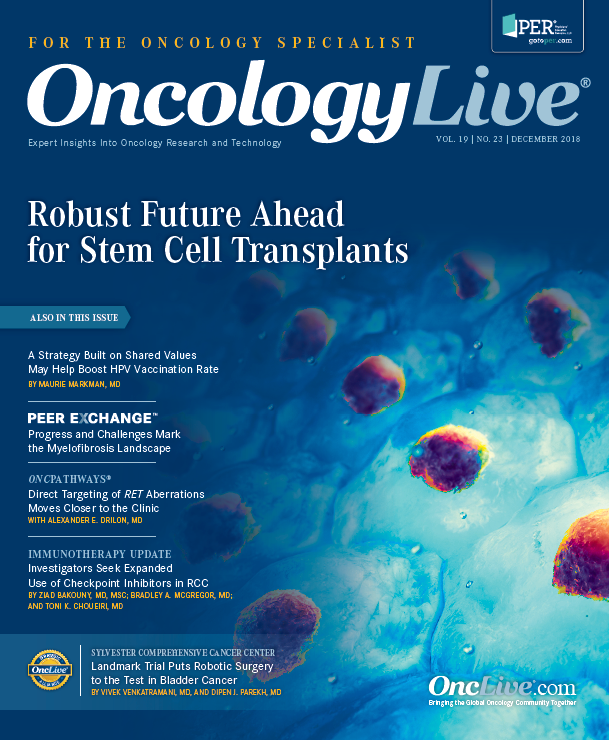New Strategies Are Needed as Ovarian Cancer Becomes a Chronic Disease
Since the introduction of platinum agents in ovarian cancer, it is reasonable to suggest there have been only limited changes in the basic paradigm of ovarian cancer management over the past several decades.
Maurie Markman, MD

Maurie Markman, MD
It was my exposure to patients with cancer during my time as an internal medicine trainee in the 1970s that led me to pursue a career in medical oncology. Perhaps the most impactful part of this experience was the opportunity to observe firsthand how patients with ovarian cancer were affected by an experimental drug just entering the clinical trials arena at that time. The agent was cisplatin, a drug requiring hospital admission, extensive monitoring, and intensive medical care for potentially debilitating adverse effects. More than one commentator has noted that cisplatin is responsible for providing the single greatest strikingly negative image of chemotherapy among patients, their families, and society at large.
I vividly remember being asked to place a routine order for a nephrology consultation on admission due to the anticipated serious potential for a major decline in renal function. Another detail that stands out is that it was necessary to have multiple very large basins at the patient’s bedside for the anticipated severe emesis, which was experienced by essentially all patients given the drug. I remember asking one of the treating physicians why we were doing this to patients with ovarian cancer. The answer was simple and direct: “Because the drug works.”
Fast forward several decades and the platinum story has largely been told; it’s a truly magnificent example of how clinical investigation has improved the welfare of patients with cancer. Although the potential for renal toxicity associated with cisplatin remains a concern, it has long been possible to deliver the drug safely in the outpatient setting, and several generations of antinausea drugs have made the emesis associated with cisplatin generally tolerable for 3 to 6 administered cycles.
Today, in the management of ovarian cancer, carboplatin has essentially replaced cisplatin due to its more favorable toxicity profile, with equivalent efficacy, making the treatment experience for most patients, although difficult, far more acceptable. However, since the introduction of platinum agents in this malignancy, it is reasonable to suggest there have been only limited changes in the basic paradigm of ovarian cancer management over the past several decades.
Yes, paclitaxel replaced cyclophosphamide, or doxorubicin, in frontline therapy due to strong evidence of superior outcomes; both improved progression-free and overall survival. Several single-agent and combination chemotherapy strategies also have been approved by the FDA over the years for the treatment of both recurrent potentially platinum-sensitive disease, which is progression more than 6 months after the completion of a frontline platinum strategy to which the patient responded, and platinum-resistant disease, which is progression less than 6 months after the completion of a frontline platinum strategy.
But, to be blunt, what we have now in ovarian cancer management is largely a simple list of reasonable therapeutic options that might be employed in patients and that will likely, at least hopefully, be paid for by third-party payers. However, there are preciously limited data as to which specific therapies should be used and in what sequence to provide optimal management for an individual patient with ovarian cancer.
In the era highlighted at the beginning of this commentary, ovarian cancer treatment was appropriately focused on the rapid control of cancer-related symptoms (eg, increasing ascites, abdominal pain, progressive weakness and debility). In most patients, this included an attempt at aggressive cytoreductive surgery followed rather quickly with combination cytotoxic chemotherapy. This “acute care” model was unquestionably successful in alleviating cancer symptoms in most patients with ovarian cancer and in prolonging survival.
Today, it is understood that for as many as 20% of patients presenting with advanced disease, there will be no further clinical evidence of disease during the remaining years of their life following the completion of the primary treatment program, which typically comprises surgery plus chemotherapy. However, for the remaining approximately 80% of patients, the disease will either not respond in a meaningful manner to cytotoxic chemotherapy (20% of those treated overall) or there will be documented evidence of recurrence following an initial response.
Our existing classification schema simply divides this large group of patients into the above-noted disease categories of potentially platinum-sensitive and platinum-resistant. This terminology and view of disease management was quite rational at a time when there were very few available therapeutic options and no reason, other than patient choice and drug toxicity, to select one strategy over another. Plus, with the available therapeutic armamentarium we had during this era, the anticipated ultimate survival for an individual patient, even with potentially platinum-sensitive recurrent disease, was limited.
It is not my intent to specifically address the clinically meaningful advances that have occurred in ovarian cancer management over many years. However, now, with carefully considered surgical interventions, other localized therapies (eg, external-beam radiation and interventional radiographic procedures) and, most importantly, the introduction of novel antineoplastic therapeutics (cytotoxic, antiangiogenic, immunotherapeutic agents, PARP inhibitors, etc) and new strategies being tested, and to be tested, in the near future, it is highly appropriate to increasingly consider advanced ovarian cancer in many individuals to be a very serious, life-threatening, and likely fatal chronic disease.
In this rapidly changing scenario, the selection of strategies from a menu with limited or no consideration for how a given decision may impact the next treatment option or a patient’s future quality of life must increasingly be seen as problematic. For example, oncologists today have to choose the most appropriate second-line or later single-agent maintenance strategies from among several FDA-approved options (eg, 3 PARP inhibitors, bevacizumab).1-5 Patient choice is critical in this discussion, but how can the choice of best drug options and sequencing strategy for the individual be appropriately informed by objective data?
Although regulatory approval for these agents is a critically important form of initial approval to administer an antineoplastic, it is far from sufficient to determine the optimal use of available management options. It is here that the gynecologic cancer research community can play a vital role in exploring these questions, possibly through the design, initiation, and rapid completion of focused, real-world, and pragmatic clinical trials.
Further, with the world of precision medicine now spectacularly reaching the ovarian cancer arena, how will this paradigm-changing concept alter our current and future decision making for patients with ovarian cancer? For example, the presence of microsatellite instability—high (MSI-H) cancer cells has been shown to predict for the clinical benefit associated with checkpoint inhibitor immunotherapy, and this strategy has been approved for use by the FDA agnostic to specific tumor type. However, only about 2% of epithelial cancers exhibit an MSI-H molecular profile.6 Therefore, the question to be asked is: Do oncologists today routinely consider this test for patients with ovarian cancer considering that only 1 in 50 malignancies will be found to have the profile currently suggesting clinical benefit from a checkpoint inhibitor? If the answer is “No,” then the next question must be, “Why not?” Consider an even more difficult scenario, one related to the presence of an activating EGFR mutation, which is well established as a standard-of-care biomarker in non—small cell lung cancer. The FDA-approved agents in this setting are not approved for the treatment of ovarian cancer, but a phase II trial exploring the clinical utility of gefitinib (Iressa), a tyrosine kinase inhibitor of EGFR) in ovarian cancer found that the cancer in the single patient in the study who responded to this agent possessed such a molecular abnormality.7 Unfortunately, based on existing data, fewer than 1 in 30 tumors in patients with ovarian cancer will be found to contain this mutation. Again, the question to be asked is whether an individual oncologist in the future will consider an evaluation of a patient’s cancer for the presence of this or another possible uncommon or rare actionable mutation in the management of patients with ovarian cancer during their journey through this chronic disease process. If not, why not?
Finally, I end this commentary with a return to the critical issue of quality of life and emphasize that the determination of this clinical parameter must be defined by the patient herself, likely in concert with her advisors—family and members of the clinical team. What may be an acceptable potential or existing adverse effect for one individual may not be for another, particularly considering the concern for more chronic negative effects impacting an individual patient over a far longer period of cancer survival.
References
- Aghajanian C, Blank SV, Goff BA, et al. OCEANS: A randomized, double-blind, placebo-controlled phase III trial of chemotherapy with or without bevacizumab in patients with platinum-sensitive recurrent epithelial ovarian, primary peritoneal, or fallopian tube cancer. J Clin Oncol. 2012;30(17):2039-2045. doi: 10.1200/JCO.2012.42.0505.
- Coleman RL, Brady MF, Herzog TJ, et al. Bevacizumab and paclitaxel-carboplatin chemotherapy and secondary cytoreduction in recurrent, platinum-sensitive ovarian cancer (NRG Oncology/Gynecologic Oncology Group study GOG-0213): a multicenter, open-label, randomized, phase 3 trial. Lancet Oncol. 2017;18(6):779-791. doi: 10.1016/S1470-2045(17)30279-6.
- Mizra MR, Monk BJ, Herrstedt J, et al; ENGOT-OV16/NOVA Investigators. Niraparib maintenance therapy in plat-inum-sensitive, recurrent ovarian cancer. N Engl J Med. 2016;375(22):2154-2164. doi: 10.1056/NEJMoa1611310.
- Pujade-Lauraine E, Ledermann JA, Selle F, et al; SOLO2/ENGOT-Ov21 investigators. Olaparib tablets as main-tenance therapy in patients with platinum-sensitive, relapsed ovarian cancer and a BRCA 1/2 mutation (SOLO2/ENGOT-Ov21): A double-blind, randomized, placebo-controlled, phase 3 trial. Lancet Oncol. 2017;18(9):1274-1284. doi: 10.1016/S1470-2045(17)30469-2.
- Pujade-Lauraine E, Ledermann JA, Selle F, et al; SOLO2/ENGOT-Ov21 investigators. Olaparib tablets as main-tenance therapy in patients with platinum-sensitive, relapsed ovarian cancer and a BRCA 1/2 mutation (SOLO2/ENGOT-Ov21): A double-blind, randomized, placebo-controlled, phase 3 trial. Lancet Oncol. 2017;18(9):1274-1284. doi: 10.1016/S1470-2045(17)30469-2.
- Le DT, Durham JN, Smith KN, et al. Mismatch repair deficiency predicts response of solid tumors to PD-1 blockade. Science. 2017;357(6349):409-413. doi: 10.1126/science.aan6733.
- Schilder RJ, Sill MW, Chen X, et al. Phase II study of gefitinib in patients with relapsed or persistent ovarian or primary peritoneal carcinoma and evaluation of epidermal growth factor receptor mutation and immunohistochemical expression: a Gynecologic Oncology Group study. Clin Cancer Res. 2005;11(15):5539-5548. doi: 10.1158/1078-0432.CCR-05-0462.




